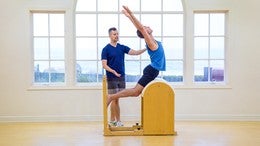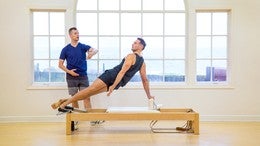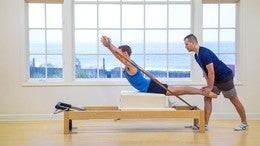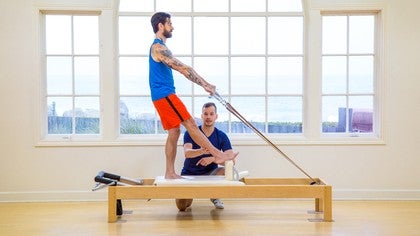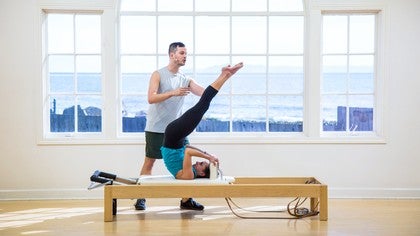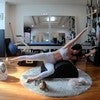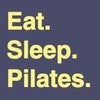Tutorial #3175
Russian Squat Progression
Description
About This Video
Transcript
Read Full Transcript
Hi everybody, I'm Benjamin. I'm here with my good friend, Frank. And we are sharing a little tutorial on the Russian squat exercise, which we will do on the reformer later on, but this video's really about trying to, demystifying the exercise somewhat, and give you some tools to figure out whether your body's ready for the exercise, as well as establish the trust in your own body to then do it on the moving platform. So we will start learning the movement itself, using the Cadillac and the arm springs, where the main difference is that the exercise does not require managing a moving surface that we stand on, and the direction of pull from the support that we work with pulls us up, rather than down, which is a really nice way to figure out, does my body have the foldability to get down into a full squat? So, Frank, go ahead and grab the handles, and position yourself about a spring and arm length away from the apparatus.
All right, so the second he begins moving down, the springs should start to open, which provides him with a lot of support, and the springs begin to pull him up and forward, so that his body can really settle back and down. So with the feet at about hip distance apart, and initially, perhaps, a little bit turned out, go ahead and bend your knees, and sit your butt down on the ground, if that's available to you. Because the springs are pulling him up, it gives him a little bit of a lift through his upper back, which we will need on the reformer in a little bit as well. Make sure that you have weight in your heels, in both of them evenly, so that you can lift yourself back up coming out of a seated position, all the way up to standing. We'll do that one more time, bending the knees to come down, using the full support of the springs here, creating a nice little plumb line from your head down into your tail.
It is okay to let it curl under slightly to get into that deep squat. And then lift yourself all the way back up. You can make the exercise more challenging by just walking a little bit closer and adding a dynamic component here, which probably will mean that you have to start pulling the handles towards you, as you start losing support from the springs. So trying it here, Go ahead and pull the elbows back a slight little bit so that you create some tension on the springs to help you lift back up, right? So you use the springs for support here.
After you've done that a few times, which we will also do on the reformer, is to go into a pistol squat. And that is essentially doing the same thing on one leg, so I suggest standing together with your feet. Take one leg out in front of you. It's really not so much about lifting this leg up high as much as it is to send some energy through that leg so it can be super low, just high enough so it doesn't touch the ground. As you bend your standing leg, use the support of the springs as symmetrically as possible, and then pull yourself back up.
So you see need the spring support quite strongly on the one-legged version. Let's do that one more time on this side, bending the knee, sitting down, and using the pole to lift the body back up. Let's try the other side, which is often a whole different story, right? Squatting, obviously, is super important skill, to have a birthright of our body, so to speak, right? So we try to foster a really good way to let the hips sink, the knee fully bend, and still manage our body weight on that foot.
So you can go ahead, bending down, and then pulling back up. As you have the support of the springs, do one more. Really think about symmetry and how your hips respond to that, so we don't let the hips sag, and keeping the shoulders on top of the hips. You can release that foot down, and we let the arm springs go. So this is a super safe environment to explore the Russian squat, the reformer's going to add the layer of having a moving surface underneath us and a whole different direction of pull.
So we'll take a look at that next. So now we'll take the Russian squat to the reformer, where we ultimately want to perform this exercise. There's one more thing I wanna show you to just get familiar with the idea of squatting down while pulling up on something. Earlier on, the arms springs kind of did that for us. Now we have to do that a little bit ourselves once we work with the straps which pull from a whole different direction So what we're gonna do here is hold onto the foot bar standing about a foot length away from the front of your reformer.
So just hold on to the foot bar with both hands, and then just explore your squat right here, bending your knees, and sitting your seat down towards the heels, towards the ground, and just holding yourself in position there. So you might wanna think stomach massage. You might wanna think your rolling like a ball position, and the thing you're the most interested in here is to allow the hips to sit fully down, become super free there, while creating this oppositional lift upwards. So feel as though you're lifting the kickstand out of the reformer a little bit. And you see a repositioning of the chest, which is exactly what we need in the Russian squat in a little bit.
Come back to standing, and we'll do that one more time. If you feel like your squat isn't fully solid yet, you can again, here, take the option to open your legs a little wider, turn the legs out a little farther, to find which position is best for your body, because everybody has a slight different squat framework to work with. We'll do one more here. If you can, bring your feet to parallel, and perhaps hip distance, because once we get on top of the carriage, there's limited amount of space. Let's do one more, bending the knees.
So I call this my clearing test, figuring out, am I going to be able to take this onto a moving platform. You lift your arms up against the foot bar as if you're lifting the kickstand out of the reformer. And then come all the way up. And if all of that goes well, and you wanna give it a whirl, then we get it onto the reformer. Lower the foot bar down for that, just to have real estate for us to squat down and up.
Go ahead and grab onto the shoulder blocks, position your feet opposite of them, and then bend your knee. And we're gonna start in the low position of a squat. So this is a good place to monitor how far your feet need to be in relationship to the shoulder blocks. Make sure that your heels are firmly planted down, so that you're not standing on your toes once you get into your squat. Once you're in that position, you grab the handles one at a time, and immediately lift your arms up until the straps get taut, right?
So at this point, Frank experiences the support coming through his shoulders into his back so that the hips can really sink down against the heels, hopefully keeping the weight back in the foot. We now make our first way up. I'm on two springs here, by the way, which is just about enough support to not feel like the springs hold you back, but just strong enough so that you don't feel completely loose and independent. Once you're up, extend your hips forward, keep the heels heavy, and let's make our way back down. This is where he has to lift his arms up to maintain traction on the straps, and this is similar to lifting that foot bar up, which we did a second ago.
Let's take that twice more, coming all the way up, and any amount will do here. Notice how the carriage moves just a little bit at that last phase. So as he comes back down, that's when the carriage will probably start moving a little bit again, and then by lifting his arms, he keeps it fairly well under control throughout most of the range. Let's do that one more time, coming to the top. This is where we could play around with our pistol squat here as well.
The rule is, any amount. Don't expect yourself to drop all the way down right away. It's been 20 years for me. I'm still working on that, quite strongly (laughs). Little, so bring your feet a little closer together to start so you have a better base of support.
Exactly, and then take one leg out in front of you. Just like on the Cadillac, it's not about the height of the leg, but much more about the energy that you give this leg so that it clears the carriage. Bend your standing leg, lift both arms up evenly, find the place where you start to lose your control to then press your standing heel back down. Lift yourself back up. Use the support of your straps.
Let's do one more on this side. Nice. And press back up. So obviously, what we're looking for here is, you can change sides, is stability through the standing leg as it bends. Become really interested with how you shift your weight in your foot, where the knee goes in relationship to your foot and your toes, and the second you feel like you're losing that stability, it's best to just stay there, breathe, once, twice, five times, and then come back up to standing.
Let's do the other side. So the right foot really absorbs his weight, down into the carriage. The arms lift as he bends the knee, left leg has energy, but doesn't have to lift super high, and we come back up. Gorgeous. Yeah, try one more here, lowering, and lifting.
The reason I find this exercise so valuable to teach to a lot of people is because nothing says concentration and empowerment like this exercise at the end of a good, hard reformer workout. To dismount now, go ahead and take a squat on both feet, let your chest come forward on this one so that the second the carriage is closed, you can lose the handles, and step away, off to the side. It's a safe way to get off. And that is the Russian squat, and a lot of progressions that you can use to find your way to do it on the reformer, and I hope you will.
The Pilates Essentials: Exercise Breakdown Tutorials
Comments
You need to be a subscriber to post a comment.
Please Log In or Create an Account to start your free trial.
